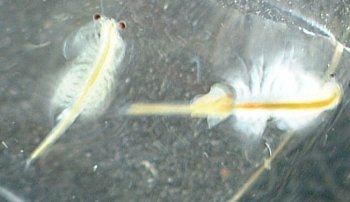|
|
|
About Brine Shrimp
Brine shrimp are microscopic creatures that are known to live in water with high salinity levels, such as the Great Salt Lakes. Brine shrimp have adapted to the frequent changes in their environment, by producing their offspring in cysts, a type of aquatic egg, if the environment becomes unfit. The baby brine shrimp can survive in their cysts for decades; once the cysts are introduced to the right conditions they hatch from their cysts and continue maturing. Brine shrimp are not only adaptable to their environment, but are also used to feed many various aquatic life, such as sea horses, pipe fish, even birds like gulls, and grebes eat brine shrimp as a main diet.
|
 Baby Brine Shrimp
These are called Naupilli because of the stage of life they are in
Baby Brine Shrimp
These are called Naupilli because of the stage of life they are in |
|
Intro to my Experiment
As a marine biology student, it has been observed that brine shrimp are often used as a significant source of food for many aquatic animals. This gave reason to question whether certain factors would affect the effectiveness of brine shrimp growth, along with sparking the question: What is the most effective way to raise brine shrimp? Possibly even more significant is whether or not certain environmental conditions can encourage brine shrimp to hatch from their cysts.
It has been observed, that in the wild brine shrimp hatch mainly in water with salinity that is at 1.022 ppt. with a temperature that is approximately seventy-five degrees celsius.
|
|
Purpose
The purpose of this experiment is to determine the most effective way to raise brine shrimp. While controlling different factors in the habitat, this experiment will establish which conditions might encourage the brine shrimp to hatch from their cysts.
Desarae's other site
Hypothesis
It is hypothesized that the brine shrimp will hatch the most, and live the longest in the bottles that are placed in light for periods of twelve hours, because light in the wild is only present for half a day.
It has also been hypothesized, that in the habitat, brine shrimp hatch mainly in water with salinity that is at 1.022 ppt. with a temperature that is approximately seventy-five degrees celsius.
Desarae's Group
|
 Adult Brine Shrimp
If you look at the appendages these are the fealers that help them swim, breath, and move food into the digestive tract. The digestive tract is located in the center of their body and appears orange in this picture.
Adult Brine Shrimp
If you look at the appendages these are the fealers that help them swim, breath, and move food into the digestive tract. The digestive tract is located in the center of their body and appears orange in this picture. |
Above is a drawing of the male and female Brine Shrimp
This drawing distinctly shows the differences and identifying traits of the male and female |
|
|


